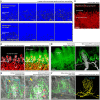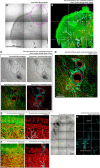3-D neurohistology of transparent tongue in health and injury with optical clearing
- PMID: 24155698
- PMCID: PMC3805177
- DOI: 10.3389/fnana.2013.00036
3-D neurohistology of transparent tongue in health and injury with optical clearing
Abstract
Tongue receives extensive innervation to perform taste, sensory, and motor functions. Details of the tongue neuroanatomy and its plasticity in response to injury offer insights to investigate tongue neurophysiology and pathophysiology. However, due to the dispersed nature of the neural network, standard histology cannot provide a global view of the innervation. We prepared transparent mouse tongue by optical clearing to reveal the spatial features of the tongue innervation and its remodeling in injury. Immunostaining of neuronal markers, including PGP9.5 (pan-neuronal marker), calcitonin gene-related peptide (sensory nerves), tyrosine hydroxylase (sympathetic nerves), and vesicular acetylcholine transporter (cholinergic parasympathetic nerves and neuromuscular junctions), was combined with vessel painting and nuclear staining to label the tissue network and architecture. The tongue specimens were immersed in the optical-clearing solution to facilitate photon penetration for 3-dimensiontal (3-D) confocal microscopy. Taking advantage of the transparent tissue, we simultaneously revealed the tongue microstructure and innervation with subcellular-level resolution. 3-D projection of the papillary neurovascular complex and taste bud innervation was used to demonstrate the spatial features of tongue mucosa and the panoramic imaging approach. In the tongue injury induced by 4-nitroquinoline 1-oxide administration in the drinking water, we observed neural tissue remodeling in response to the changes of mucosal and muscular structures. Neural networks and the neuromuscular junctions were both found rearranged at the peri-lesional region, suggesting the nerve-lesion interactions in response to injury. Overall, this new tongue histological approach provides a useful tool for 3-D imaging of neural tissues to better characterize their roles with the mucosal and muscular components in health and disease.
Keywords: neural network; neurohistology; neuromuscular junction; optical clearing; papilla; skeletal muscle; tongue innervation; tongue lesion.
Figures





Similar articles
-
3-D imaging and illustration of mouse intestinal neurovascular complex.Am J Physiol Gastrointest Liver Physiol. 2013 Jan 1;304(1):G1-11. doi: 10.1152/ajpgi.00209.2012. Epub 2012 Oct 18. Am J Physiol Gastrointest Liver Physiol. 2013. PMID: 23086917
-
Human liver afferent and efferent nerves revealed by 3-D/Airyscan super-resolution imaging.Am J Physiol Endocrinol Metab. 2024 Feb 1;326(2):E107-E123. doi: 10.1152/ajpendo.00205.2023. Epub 2024 Jan 3. Am J Physiol Endocrinol Metab. 2024. PMID: 38170164
-
Imaging of the islet neural network.Diabetes Obes Metab. 2014 Sep;16 Suppl 1:77-86. doi: 10.1111/dom.12342. Diabetes Obes Metab. 2014. PMID: 25200300 Review.
-
Human pancreatic afferent and efferent nerves: mapping and 3-D illustration of exocrine, endocrine, and adipose innervation.Am J Physiol Gastrointest Liver Physiol. 2019 Nov 1;317(5):G694-G706. doi: 10.1152/ajpgi.00116.2019. Epub 2019 Sep 11. Am J Physiol Gastrointest Liver Physiol. 2019. PMID: 31509431
-
[Progress in the effects of injury and regeneration of gustatory nerves on the taste functions in animals].Sheng Li Xue Bao. 2014 Oct 25;66(5):519-27. Sheng Li Xue Bao. 2014. PMID: 25331997 Review. Chinese.
Cited by
-
An advanced optical clearing protocol allows label-free detection of tissue necrosis via multiphoton microscopy in injured whole muscle.Theranostics. 2021 Jan 1;11(6):2876-2891. doi: 10.7150/thno.51558. eCollection 2021. Theranostics. 2021. PMID: 33456578 Free PMC article.
-
The transcription factor Phox2b distinguishes between oral and non-oral sensory neurons in the geniculate ganglion.J Comp Neurol. 2017 Dec 15;525(18):3935-3950. doi: 10.1002/cne.24312. Epub 2017 Sep 15. J Comp Neurol. 2017. PMID: 28856690 Free PMC article.
-
Q&A: How can advances in tissue clearing and optogenetics contribute to our understanding of normal and diseased biology?BMC Biol. 2017 Sep 25;15(1):87. doi: 10.1186/s12915-017-0421-3. BMC Biol. 2017. PMID: 28946882 Free PMC article.
-
Intravital microscopic interrogation of peripheral taste sensation.Sci Rep. 2015 Mar 2;5:8661. doi: 10.1038/srep08661. Sci Rep. 2015. PMID: 25726964 Free PMC article.
-
3-D imaging of islets in obesity: formation of the islet-duct complex and neurovascular remodeling in young hyperphagic mice.Int J Obes (Lond). 2016 Apr;40(4):685-97. doi: 10.1038/ijo.2015.224. Epub 2015 Oct 26. Int J Obes (Lond). 2016. PMID: 26499436
References
-
- Arvidsson U., Riedl M., Elde R., Meister B. (1997). Vesicular acetylcholine transporter (VAChT) protein: a novel and unique marker for cholinergic neurons in the central and peripheral nervous systems. J. Comp. Neurol. 378, 454–467 10.1002/(SICI)1096-9861(19970224)378:4<454::AID-CNE2>3.0.CO;2-1 - DOI - PubMed
-
- Carl Zeiss Microimaging GmbH. (2009). Visualizing the Architecture of Cells and Tissues. Brochures for Laser Scanning Microscopy. Available online at: http://microscopy.zeiss.com/microscopy/en_gb/downloads/brochure-download... [Accessed 06 August 2013].
LinkOut - more resources
Full Text Sources
Other Literature Sources

